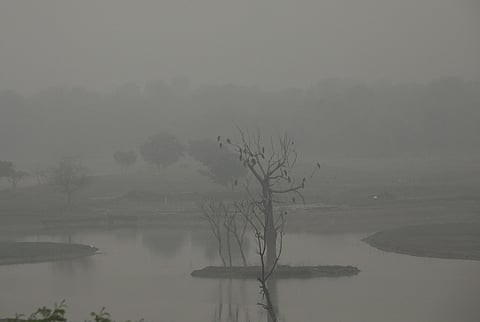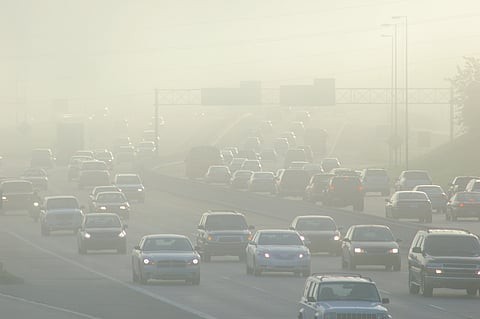



Air pollution is a critical environmental and public health issue, contributing to respiratory illnesses, child mortality, and climate change. Major sources include industrial emissions, vehicular pollution, coal dependence, and crop residue burning. Weak enforcement of environmental regulations and rapid urbanization exacerbate the problem. Case studies from India and globally show that integrated policies, clean energy adoption, sustainable agricultural practices, and strict regulatory measures can help reverse the trend, improving air quality and public health.

Copyright infringement not intended
Picture Courtesy: Down to Earth
People living in the Indo-Gangetic Plain (IGP)—spanning northern India, eastern Pakistan, southern Nepal, and most of Bangladesh—lose about seven years of life expectancy compared to those living elsewhere.
According to State of Global Air (SOGA) 2024 report;
Neurodevelopmental and Physical Effects
Gut and Immune Health
Exposure Begins Before Birth: Polluted air affects both maternal and foetal health. Tiny particles like PM2.5 and harmful gases such as nitrogen dioxide (NO₂) can cross the placenta and enter the baby’s bloodstream. This exposure interferes with foetal growth, leading to:
Neonatal and Infant Vulnerability: After birth, children continue to inhale polluted air at a much higher rate relative to their body weight. Their respiratory systems are smaller and more fragile, and they breathe faster than adults. Pollutants like PM2.5, black carbon, and ozone can easily enter deep into their lungs and bloodstream, causing:
Household Air Pollution: In many low- and middle-income countries, household air pollution from burning solid fuels for cooking is a hidden but deadly factor. In poorly ventilated homes, children are constantly exposed to smoke containing fine particles and toxic gases. This exposure has been linked to:
Rapid Urbanisation and Industrial Growth
A report titled “What are the Critical Challenges in India’s Air Quality Monitoring Framework?” outlines how some monitoring stations are poorly sited (e.g., in low‑pollution zones, behind obstructions), suffer downtime due to power/outage issues, and lack staff capacity. Source: cseindiaa.org)
Dependence on Fossil Fuels and Dirty Energy
Agricultural Practices and Crop Residue Burning
Weak Enforcement of Environmental Regulations
CAG Report: A CAG audit of Delhi’s vehicle‑pollution control found over 1.08 lakh vehicles were issued ‘Pollution Under Control’ (PUC) certificates despite emitting beyond permissible limits.
Cross-Border Pollution and Regional Coordination
CAG Report: A Supreme Court order (1998) requiring two new inter‑state bus terminals (ISBTs) to reduce diesel bus entry was not complied with even by 2021.
Evidence: Delhi’s odd-even vehicle scheme (2016) temporarily reduced PM₂. ₅ by 10–15% in winter.
Case Study: Closing or retrofitting coal-fired power plants in India could have saved 720,000 lives over a decade.
Evidence: Punjab and Haryana implemented mechanized “Happy Seeder” programs.
Result: Reduction in stubble burning incidents by 20–30% in pilot districts.
Case Study: Pradhan Mantri Ujjwala Yojana (LPG connections for rural households) significantly reduced indoor and ambient PM₂.₅.
Air pollution is a pressing environmental and public health challenge, contributing significantly to respiratory diseases, child mortality, and overall morbidity. Its causes are multifaceted—ranging from industrial emissions and vehicular exhaust to coal dependence and agricultural practices like crop residue burning. While policies, technology, and community-level interventions have shown success in certain regions, persistent challenges such as weak regulation enforcement, economic constraints, and behavioural barriers hinder progress. Combating air pollution effectively requires integrated strategies that combine stricter regulations, clean energy transition, sustainable agricultural practices, public awareness, and robust monitoring to safeguard health and ensure environmental sustainability.
Source: Down to Earth
|
Practice Question Q. Discuss the major sources of air pollution in India, their impact on public healthespecially on children and suggest strategies to reverse the trend. Support your answer with case studies, reports, or data wherever possible. (250 words) |
Delhi, Ghaziabad, Kanpur, Lucknow, Varanasi, and Patna consistently rank among the most polluted cities according to the World Air Quality Report.







© 2025 iasgyan. All right reserved